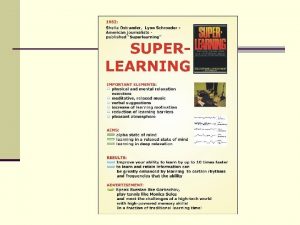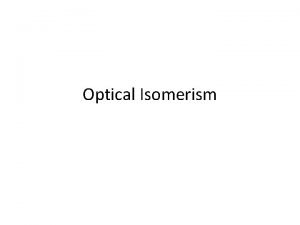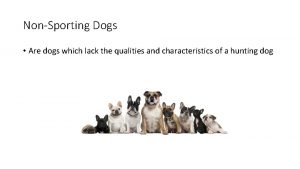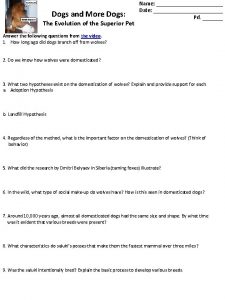Are All Dogs the Same Wayne Ostrander 2007

















































- Slides: 49

Are All Dogs the Same?

Wayne & Ostrander 2007 Why dogs? Dog Genome Project • Important species: • Lots of phylogenic diversity • Relatively known course of development • Can divide into segregated phenotypes that correlate with breeds

Ontogeny of social behavior in Canids • Domestication results in both physical and behavioral changes • Physical changes include: – – • Larger size variation: dwarf and giant Piebald coat color Reproductive cycle changes Changes in hair, shortened tails, floppy ears Social changes: – Lack of development of fear to humans – Exhibiting play behavior in adulthood – Prolonged juvenile period

Several close relatives • Phenotypically divergent taxa (animals) – Wolf – Fox – South-American canids (most close to current dogs genetically) • Current dogs most close relative: Grey wolf • Line of canids may go back as far as 50 million years • Current “dogs” about 10 -15, 000 years


Modern breeds • Closed gene pools • Real breeding began in Victorian era – Selective breeding began – Huge phylogenic diversity • Result: loss of much of genetic diversity – More diversity across breeds – But less overall genetic diversity with other close relatives – In way: Breeds are becoming different “species”

Distinct evolutionary hierarchy Four or five primary groups: Organization of modern breeds • Ancient • Herding • Mastiff • Modern European • Mountain Most divergent of these groups = nine ancient breeds from Artic, Asia, Africa, Middle East Most modern breeds = European • Share single exclusive common ancestor • Show little difference across phylogenetic structure • This indicates recent origin and limited interbreed hybridization

Where did dogs come from?


Discovery of new disease genes Metabolic and endocrine disorders Blindness Cancer Deafness Hip dysplasia Osteoarthritis Why is this so important Give distinct clues for human genetics and treatments of humans as well as dogs

What about behavior • Just beginning to investigate behavior of dogs across breeds – Examine how breed and behavior correlate – Examine how behavior disorders interact with breed • OCD, separation anxiety, etc.

James Hsu and his colleagues at the Center for the Interaction of Animals and Society of the University of Pennsylvania [35], [36]. The C-BARQ®: Canine Behavioral Assessment and Research Questionnaire The CBARQ Designed to provide dog owners and professionals with standardized evaluations of canine temperament and behavior. Undergone extensive testing to establish reliability and validity using large samples of many dog breeds The questions asked of dog owners target behavioral traits, aggression and general temperament of the dogs.

C-BARQ • 101 items that ask owners to indicate how their dogs have responded “in the recent past” to a variety of environmental events and stimuli. • Owners use a series of 0– 4 rating scales. • The wording of individual rating scales differs depending on the questions. • For example, Owners may be asked to note the – – • frequency of a behavior (0 = never, 1 = seldom, 2 = sometimes, 3 = usually, and 4 = always) Quality of the behavior (0 = no signs of the behavior, 1– 3 =mild to moderate signs of the behavior, and 4 = severe signs of the behavior). A brief explanation is included for the qualitative items – e. g. , “Typical signs of moderate aggression in dogs include barking, growling, and baring teeth. More serious aggression generally involves snapping, lunging, biting, or attempting to bite”.

C-BARQ subscales • 5 main subscales: – Aggression – Fear/anxiety – Excitability – Separation-related behavior – Attachment • Other subscales include – Stranger-directed behavior – Owner directed behavior – Object-directed behavior. • Additional items on the questionnaire evaluate trainability • Also a subset of 21 items that appear to predict canine behavior but do not load on the main 5 subscales.

How can the CBARQ be used? • Examine behavior across different populations of dogs • Predict which breeds might be prone to particular behavioral issues • Genetics studies as well! • We have used it in our lab to examine deaf vs. hearing dogs

WHY Deaf and Blind Dogs? • Hearing and vision impaired (HVI) are an increasing population in animal shelters, foster programs and rescue organizations. • The number of blind dogs estimated at approximately 300, 000, but very little reliable data • Estimates of the deaf dogs in the US in 2010 suggest about 35, 000 bilaterally deaf dogs, and approximately 120, 000 dogs with unilateral loss. • Approximately 5% of canine pets are hearing or vision impaired (Deaf Dogs forever, 2010).

WHY HVI dogs? • – – • – – – Variety of congenital conditions that result in blindness and deafness Several eye disorders have become dominant in certain breeds, esp. Collie Eye, cataracts, lenticular sclerosis Congenital deafness typically result when two recessive genes are passed on from the parents. Double Merle mutation too much color removed from hair cells, particularly those in the inner ear, resulting in deafness. • No action potentials possible on cochlea Results in sensorineural hearing loss Also commonly affects eye development

HVI dogs, unlike normal hearing/vision (NVI) dogs, are unable to benefit from early experience regarding vocalized or positional social interactions, Otherwise appear to develop normally. How are HVI Dogs Different? Lots of folklore about HVI dogs: suggest are more aggressive, startle more easily, cannot be trained and cannot make good pets • AKC and breed clubs mandate euthanasia for HVI dogs • Suggest are too dangerous to keep as pets But- no data to support these assertions.

• How are HVI Dogs Different? Uncovering behavioral differences between HVI and NHV dogs: – Helps gain an understanding of how HVI dogs compensate for the loss of vocalized or visual cues during social interactions. – Allows us to examine effects of early experience on canine behavior – Provides data from which to evaluate folklore assertions • Provides a basis for understanding innate versus learned socialization patterns in the domestic canine. • But where to start? Perhaps looking at data for deaf and blind humans.

Social Skills Deficits in Deaf/HOH children Social interactions and social skills deficits • Vocal volume control • Interpreting vocal nuances (sarcasm, emotions, intent ) • More isolation and solitary play • Unemotional responses to social situations • poorer empathy development • Greater negativity and more immature and neurotic behavior • (Barchara, Raphael & Phelan, 1980; Goetzinger & Proud, 1975) Odom, Blanton &Lauichuf, 1973; Reinvich & Rothrock, 1977) Children with visual or hearing impairments often engage in selfstimulatory behaviors (Wright (2008): • rocking or self-soothing behaviors, • higher degrees of oral stimulation, • tendency to seek tactile stimulation

Question: Do HVI dogs show similar social behavior deficits to deaf and blind children? The Deaf Dog Project Compared the behavior of HVI dogs to NHV dogs • Behavioral traits • Cognitive and social abilities • Use deficits in deaf and blind children as a starting place for examining differences Today’s presentation will briefly report on several experiments recently conducted in the Canine Behavior and Cognition lab at Illinois State University.

• Survey Study Deaf vs. Hearing Dog Behavioral Traits Undergraduate assistants: Mandy Quick, Kelsey Harper and Kristin Schmidt • • CBARQ survey (Serpell and Hsu, 2003): Again, 5 main subscales: • Aggression • Fear/Anxiety • Excitability • Separation-related behavior • Attachment – Also a subset of 21 items that appear to predict canine behavior but do not load on the main 5 subscales. Online survey – International Owners of 183 HVI dogs – 277 dogs with no disability

Results • A multiple analysis of variance (MANOVA) was conducted on the data using breed, age and hearing/vision status as the independent variables. – No breed or age differences found – No differences between blind and deaf dogs, thus combined into single category

HVI dogs rates as significantly LESS aggressive! HVI dogs rates as significantly LESS anxious!

HVI dogs rated as having slightly MORE separation anxiety HVI dogs rated as significantly LESS excitable

HVI dogs rated as attached to their owners as NHV dogs HVI dog owners more likely to use hand signs, physical prompts and combinations of training methods Also more likely to provide training.

Individual Behaviors • NHV dogs more likely to • Roll in feces • Eat feces • HVI dogs more likely to engage in self stimulatory behavior: inappropriate and/or excessive • Chewing • Barking • Licking

Summary of Survey Data • Data suggest that HVI dogs show no more to somewhat less problematic behavior than NHV dogs. • Deficits that are found are consistent with those found in deaf and blind children – Separation anxiety – Perseverative behavior – No more aggression, excitability or general anxiety • But perhaps the owners are underestimating the degree of problems? • Conduct behavioral assessments of HVI and NHV dogs.

Need to examine actual behavior! • Surveys are great, but need to examine actual behavior between deaf and hearing dogs • Support survey data • Allows experiments to examine differences in behavior across deaf and hearing dogs.

CANINE-ALITYTM AND SAFERTM ASSESSMENTS AS BEHAVIORAL PREDICTORS TO DISTINQUISH DEAF AND HEARING DOGS • Participants: 9 HVI and 5 NHV Australian Shepherd dogs, ages 1 to 5, mean age 2. 8. • Procedure: Two assessments were given to the dogs: – Canine-ality. TM Assessment: • 6 item personality assessment: Left Alone, Greeting, Crate, Play test, Food motivation, Manners – SAFERTM assessment: • 7 -item canine aggression assessment • Look; Sensitivity; Tag; Paw Squeeze; Food Behavior; Toy Behavior; Dog-to. Dog behavior • Scores are used as prescriptive for behavioral intervention.

Results • HVI dogs showed greater anxiety on LEFT ALONE subscale – R=. 702, F(1, 14)=12. 64, p=. 004, ß=. 702. • Male dogs were more likely to receive a higher (poorer) score on the Manners subscale. – R=. 593, F(1, 14)=7. 06, p=. 02, ß =0. 593.

Summary of Behavioral Assessments • Only Australian Shepherds were examined to control for breed differences – this breed has a a high rate of HVIs (approximately 18%). • HVI dogs did differ from NHV dogs in terms of separation anxiety, confirming the trend found in the survey study • Does confirm, again, that HVI Australian Shepherds do not appear to exhibit the severe behavioral problems cited by breed-specific clubs or the AKC. • Next: examine differences across specific social settings

ACQUIRING FOOD PREFERENCES FROM INTERACTION WITH HVI vs. NHV CONSPECIFICS • Participants: 8 HVI and 6 NHV dogs. • Australian Shepherds, Labs, Golden Retrievers, Boxers, Pit Bulls • Ages 1 to 11; mean for HVI = 2. 8; mean for NHV = 5. 5 • Dogs served as both the demonstrator and the recipient. Each dog was tested at least three time for each condition. • Four conditions: • HVI demonstrator to HVI recipient; HVI demonstrator to NHV recipient • NHV demonstrator to HVI recipient; NHV demonstrator to NHV recipient • Replication of: Lupfer-Johnson, G. & Ross, J. (2007). Dogs acquire food preferences from interacting with recently fed conspecifics. Behavioral Processes, 74, 104 -106.

RESULTS • Significant difference for same/different food, F(1, 12)=45. 91, p=. 049 • Significant difference in amount consumed by HVI or NHV dogs, F(1, 12)=29. 66, p<. 001. • Dogs ate more of the food presented to the demonstrator dog, regardless of whether they were HVI or NHV but HVI dogs ate more overall.

Why are these results important? • HVI and NHV dogs should not necessarily differ in their scent experiences. – Both dogs use scent as social signals – No impairment in HVI dogs for scent cues • Demonstrates that in noninvolved sensory areas, HVI and NHV dogs show similar social patterns. • But what about areas that HVI and NHV dogs DO differ?

• DIFFERENCES IN PLAY BETWEEN HVI and NHV DOGS • Subjects: 7 HVI dogs and 7 NVH dogs – Australian Shepherds, boxers, labs, goldens, mixes, pit bulls – Ages ranged from 1 to 8; mean for HVI = 3. 5; mean for NHV = 3. 7 – Dog play dyads were videotaped during 5 minute free play – Dogs paired in same (e. g. , HVI to HVI) or different (HVI to NHV) conditions Data analysis: – videotape sessions analyzed using 10 sec point in time sampling. – Horowitz’s play scale • • • Play signals: Attention getting play behavior Non-attention getting play behavior Other non-play behaviors Replication of: Horowitz, A. (2009). Attention to attention in domestic dog (Canis familiaris) dyadic play. Animal Cognition, 12, 107 -118.

HVI dogs engaged in more overall play than NHV dogs particularly when playing with other HVI dogs. This decreased, but not significantly, when playing with NHV dogs.

HVI dogs engaged in more attention getting behavior NHV dogs particularly when playing with other HVI dogs. This decreased, but not significantly when playing with NHV dogs.

HVI dogs engaged in more ignoring of attention getting behavior than NHV dogs particularly playing with other HVI dogs. This decreased when playing with NHV dogs.

HVI dogs showed more physical interactions than NHV dogs. This decreased during mixed play. HVI dogs barked significantly more than NHV dogs, and this increased during mixed play. Both HVI and NHV dogs showed reduced non-play behavior during mixed play conditions.

Play differs! • As expected, HVI dogs show different play patterns than NHV dogs. – More attention getting, less responding to attention cues – More physical interactions such as leap on • Similar to deaf and blind children, who are also very tactile – Much more and louder barking • Again, similar to deaf children. ’s vocal control difficulties • HVI showed more and NHV dogs showed less physical play when playing with a similarly-abled dog than when playing with a differently-abled dog • But how do HVI dogs interact with humans?

• Participants: 10 HVI and 10 NHV dogs. • Australian Shepherds, Labs, Goldens, Boxers, Pit Bulls, Mixes • All ages 1 to 10; average was 2. 8 for HVI; 5. 4 for NHV OWNERS’ EFFECT ON PET DOGS’ CHOICE • Procedure: 2 quantities of food or balls • Small: single piece of food or single ball. • Large: 8 pieces of food or 4 balls. • Three conditions: • Free choice test: Dog was free to choose either plate. • Owner showing clear preference for one plate, equal amounts • Owner showing clear preference for small quantity compared to the larger quantity of food. • Replication of: Prato-Previde, E. , Marshall-Pescini, S. , & Valsecchi, P. (2008). Is your choice my choice? The owners’ effect on pet dogs’ (Canis lupus familiarisis) performance in a food choice task. Animal Cogntion, 11, 167 -174.

RESULTS • Both HVI and NHV dogs showed general preference towards bigger reward • Both HVI and NHV dogs chose owner preferred during 1: 1 • HVI dogs were more easily swayed to choose the smaller than typical dogs • Confirmed this preference for human signals with one last study.

HEARING STATUS AS A VARIABLE PREDICTING SOCIAL LEARNING PERFORMANCE IN DOGS • Subjects: 5 HVI and 4 NHV dogs and their student trainers. • All trainers were familiar to the dogs • Australian Shepherds, Golden, Lab, Pit Bull, Boxer and Mixes • Mean age of HVI dogs=4; Mean age of NHV dogs = 6. 7 • Apparatus: A V-shaped opaque fence forming a 90 degree angle • Procedure: • Condition 1: The experimenter placed a toy behind the fence by tossing it over the upper edge. The dog was prompted to go retrieve the toy. • Condition 2: Dog models the retrieval of toy first • Condition 3: Human models retrieval of item first • Replication of: Kundey, S. M. A, De Los Reyes, A. , Royer, E. , Molina, S. , Monnier, B. , German, R. , & Coshun, A. (2011). Reputation-like inference in domestic dogs (Canis familiaris). Animal Cognition, 14, 291 -302.

Results: • HVI dogs less accurate at solving the barrier task than NHV dogs: t(7)=2. 43, p=. 05. • All dogs solved the barrier task after a human modeled the solution. • HVI dogs were less likely to follow the dog model than NHV dogs; this difference approached significance: t(7)=-2. 45, p=. 07.

What do the data tell us? • Data clearly demonstrate that HVI dogs as a group show differences in social behavior compared to their normal cohorts. • Differences include: – More physical behavior during play – Perseverative/loud barking during play – Difficulty interpreting social signals from other dogs – Greater separation anxiety for their human – More reliance on human signaling compared to dog cohorts

• Can these deficits be remediated? Large literature showing social skills deficits in deaf children can be remediated. – Braton and Osborne’s (1978); Lemanek, et al. (1986) social skills positive practice program • increased target responses for individual children • increased appropriate responses during role playing activities. – Dyck (2003): Emotional Literacy program enhanced understanding of receptive and expressive emotional responses. • Can we teach HVI dogs to improve social skills? First question- how to train!? !

But: Intriguing data from domestic dogs • Dogs like people best: – Dogs will choose to interact with humans over other dogs – Dogs will maintain rates of playing with humans even if are allowed to play with other dogs – Owner-to-dog play is typically of better quality than dog-to-dog play • Brings up a question: DO dogs need to play well with other dogs? – Is it okay for dogs to just play with people? • Not play with other dogs? • Need basic manners, but not “have” to enjoy being with other dogs – • Similar question for people: Do children who are asocial or who prefer the presence of adults, being alone, etc. HAVE to learn to play with other children? Makes us rethink our approach to social skills: • Need basic set • Do we need to be fully fluent?

Bottom Line: Take Home for the Whole Semester • Dogs are sensitive to behaviors of other animals and especially people. – Show attachment – Show ability to read human emotional signals • Dogs clearly signal their emotionality to other dogs and people. • Dogs are highly cognitive- need stimulation. – Dogs are incredibly socially perceptive – Dogs can understand learn social behavior of humans • Reinforcement training is best when “educating” dogs (just like people) • Dogs are bred and socialized to like us best. • Because of all of this, we must treat our dogs with respect, with kindness and with awe. We owe them because they give so much to us.
 Wayne ostrander
Wayne ostrander Mikael ferm
Mikael ferm Sheila ostrander and lynn schroeder
Sheila ostrander and lynn schroeder Same time same place แปลว่า
Same time same place แปลว่า Same place same passion
Same place same passion Similar figures have the same but not necessarily the same
Similar figures have the same but not necessarily the same Similar figures / proportion (level 2)
Similar figures / proportion (level 2) Trans name
Trans name Name a point that is collinear with the given points
Name a point that is collinear with the given points All paths lead to the same destination
All paths lead to the same destination The big 3 questions
The big 3 questions All humans are same
All humans are same No two people
No two people The locus of all points that are the same distance
The locus of all points that are the same distance Do all liquids evaporate at the same rate
Do all liquids evaporate at the same rate Hình ảnh bộ gõ cơ thể búng tay
Hình ảnh bộ gõ cơ thể búng tay Ng-html
Ng-html Bổ thể
Bổ thể Tỉ lệ cơ thể trẻ em
Tỉ lệ cơ thể trẻ em Voi kéo gỗ như thế nào
Voi kéo gỗ như thế nào Tư thế worms-breton
Tư thế worms-breton Chúa yêu trần thế
Chúa yêu trần thế Kể tên các môn thể thao
Kể tên các môn thể thao Thế nào là hệ số cao nhất
Thế nào là hệ số cao nhất Các châu lục và đại dương trên thế giới
Các châu lục và đại dương trên thế giới Công thức tính thế năng
Công thức tính thế năng Trời xanh đây là của chúng ta thể thơ
Trời xanh đây là của chúng ta thể thơ Mật thư tọa độ 5x5
Mật thư tọa độ 5x5 Làm thế nào để 102-1=99
Làm thế nào để 102-1=99 độ dài liên kết
độ dài liên kết Các châu lục và đại dương trên thế giới
Các châu lục và đại dương trên thế giới Thể thơ truyền thống
Thể thơ truyền thống Quá trình desamine hóa có thể tạo ra
Quá trình desamine hóa có thể tạo ra Một số thể thơ truyền thống
Một số thể thơ truyền thống Cái miệng nó xinh thế
Cái miệng nó xinh thế Vẽ hình chiếu vuông góc của vật thể sau
Vẽ hình chiếu vuông góc của vật thể sau Thế nào là sự mỏi cơ
Thế nào là sự mỏi cơ đặc điểm cơ thể của người tối cổ
đặc điểm cơ thể của người tối cổ Ví dụ về giọng cùng tên
Ví dụ về giọng cùng tên Vẽ hình chiếu đứng bằng cạnh của vật thể
Vẽ hình chiếu đứng bằng cạnh của vật thể Phối cảnh
Phối cảnh Thẻ vin
Thẻ vin đại từ thay thế
đại từ thay thế điện thế nghỉ
điện thế nghỉ Tư thế ngồi viết
Tư thế ngồi viết Diễn thế sinh thái là
Diễn thế sinh thái là Dot
Dot Số nguyên tố là
Số nguyên tố là Tư thế ngồi viết
Tư thế ngồi viết Lời thề hippocrates
Lời thề hippocrates







































































